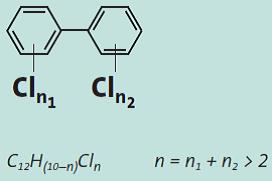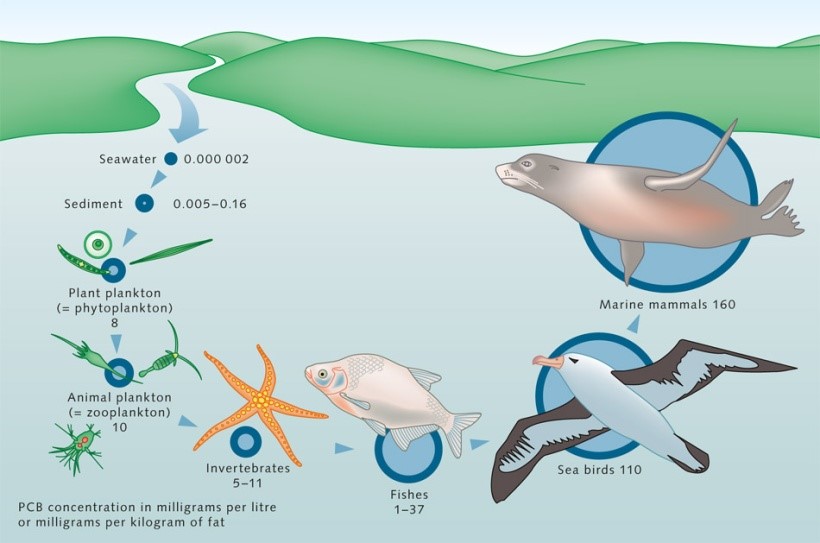Team:Paris Saclay/PCBs
From 2013.igem.org
Contents |
What are PCBs?
PolyChlorinated Biphenyls (PCBs), are a family of man-made aromatic organic chemicals which consist of two phenyl rings and several chlorines. The first PCB was synthesized in 1881 and several of them were developed during the 1940’s. The production of PCBs peaked in 1970’s, before the comfirmation that PCBs were for harmfull for human health. In 1979; the production of PCBs was banned in the U.S.A. In 1987, the total interdiction of production and usage of PCBs was promulgated in France.
The Stockholm Convention on Persistent Organic Pollutants (POPs) was signed in 2001, which aims to eliminate or restrict the production and usage of PCBs and other persistent organic pollutants. The PCB world-wide ban is effective since May 2004.PCBs are highly stable molecules. Although they are not manufactured anymore, they are still present in nature and they constitute a threat for the environment and human health. The aim of our project is to engineer, via synthetic biology approaches, bacteria that would efficiently of biodegrade PCBs.
Chronology of PCBs
| YEAR | EVENTS |
|---|---|
| 1881 | First PCBs synthesized |
| 1927 | PCBs were first manufactured commercially |
| 1968 | Yusho disease in Japan |
| 1973 | OCDE suggested of using PCBs in close system |
| 1975 | Ban of PCBs for open-air application in France |
| 1979 | Ban of PCBs production in U.S |
| 1987 | Ban of PCBs production and usage in France |
| 1992 | OSPAR COMMISSION, made decision of abandonment of PCBs |
| 2001 | The Stockholm Convention on Persistent Organic Pollutants signed |
Why are PCBs persistent in the environment?
PCBs are chlorinated derivative of biphenyls which are distinguished by the number and the position of chlorines. Because of those substituted chlorines, the degradation of PCBs releases Cl- which is toxic for almost all organisms. Organisms should be capable to deal with these Cl- ion during degrading PCBs. However, some microbes are able to decompose PCBs by two series of processes: replacement of chlorine by hydrogen known as reductive dechlorination; then use these biphenyl or as a carbon source. But in a nature system, the degradation of PCBs needs a microbial community to eliminate all PCBs, these processes are extremely slow. So in our project, we try to combine these 2 processes in one cell of bacterial.
There are up to 209 individual chlorinated compounds in total. They are chemically fairly inert, being extremely resistant to oxidation, reduction, addition, elimination, and electrophilic substitution reactions except under extreme conditions. According to a guideline of U.S EPA, the incineration for eliminating PCBs demands a temperature over 1200 degree Celsius in order to destroy totally PCBs and prevent some by-product such like dioxin.
PCBs are either oily liquids or solids that are colorless to light yellow, have low solubility in water but highly soluble in organic solvents. This high lipophilicity causes PCBs to stay in animal fats and accumulate in food chain.
Where can PCBs be found today?
Chemically speaking PCBs are extremely stable with very high thermal conductivity, high boiling point (278-415 °C) and high flash points (170 to 380 °C). They were widely used in electrical equipment such as transformers and capacitors before the ban of PCBs. Nowadays, most of contaminated products and materials are sealed in special places like other dangerous chemicals. But the risk of release or exposure of PCBs always exists.
Although PCBs are no longer produced in France, but are still found in the environment. In water of Seine, PCBs are present in substantial quantities in sediments due to the high molecular weight, but they can also attach to the surface of organic matter, clay, and micro-particles so move to the overlying water when water current suspends those particles.
PCBs in air are from PCBs in soil by volatilization. They deposit on land when it rains or snows. Like PCBs in water, PCBs present in air can also attach to particulate matter. PCBs in air tend to move to colder polar region (high altitude) because of global distillation.
PCBs can also be found in organisms especially in the aquatic system. The lipophylicity of PCBs leads PCBs accumulate in animal fatty tissues, then the quantity of PCBs amplifies by the food chain. After this bioaccumulation of PCBs, the concentration of PCBs in animal or human’s body can be hundred times greater than in the food they eat.
How can PCBs affect our health?
Studies in humans provide supportive evidence for potential carcinogenic and non-carcinogenic effects of PCBs. The different health effects of PCBs may be interrelated, as alterations in one system may have significant implications for the other systems of the body.
Non-carcinogenic effects that have been associated with PCBs include acne-like skin conditions in adult and neurobehavioral and immunological changes in children. More precisely, they are:
- immune system (suppress the immune system);
- reproductive system (decrease in the number of human sperm, increase the rate of sperm deformity, increase the rate of female infertility, decrease the animal fertility, reduce the birth weight);
- nervous system (brain damage to human body, restrain brain cell synthesis, developmental delay, reduce the intelligence);
- endocrine system (decrease thyroid hormone levels, make the aquatic animals to feminization);
- Other health effects (dermal and ocular effects, liver toxicity).
PCBs can cause cancer in animals and humans. IARC (International Agency for Research on Cancer) has taken the polychlorinated biphenyls (PCBs) as a carcinogen to humans, carcinogenic effect is the major toxic effects represents by the PCBs after reaching a certain concentration in the human body.
reference:
Polychlorinated Biphenyls, US EPA
Polychlorinated Biphenyls fact sheet 2001, ASDR
The history of PCBs
J.M. BRIGNON, les PolyChloroBiphenyles 2012 INERIS
GreenFacts
Amy Boate, Greg Deleersnyder, Jill [Howarth, Anita Mirabelli, Leanne Peck, <Chemistry of PCBs>
UK Marine Special Areas of Conservation Project
The Present Situation and the Need for Solutions
Heidelore Fiedler, Bavarian Institute for Waste Research - BIfA GmbH, Am Mittleren Moos 46a, D-86167 Augsburg, Germany 12. Polychlorinated Biphenyls (PCBs): Uses and Environmental Releases
International Agency for Research on Cancer Agents Classified by the IARC Monographs, Volumes 1–107
Clearwater, News&Bulletins, Fact Sheet 12, <What Are The Human Health Effects Of PCBs?>
Criteria and Standards Division, Office of Water Planning and Standards, U.S. Environmental Protection Agency, Washington, B.C., Ambient Water Quality Criteria, < Polychlorinated Biphenyls>
Article written by Zhou and Sheng
 "
"



